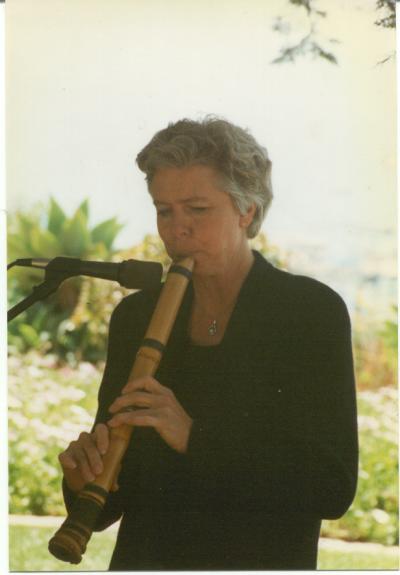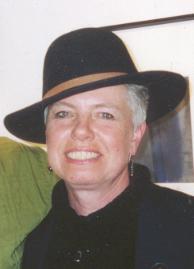
Hear Gekko Reibo (Moonlight Reverie)
The author invites responses
for a dialogue on this topic.
A Goal-Oriented Attitude A Mirror Attitude
Sound
is a Door....¿To Where?
In Asia there are many disciplines that can be studied as
a "Way," such as Kado (Flower Way), Chado (Tea Way), Shodo (Calligraphy Way),
Kyudo (Archery Way), Bushido (Warrior Way), Chikudo (Bamboo Way). These all sound very
esoteric, but in reality a "Way" is NOTHING SPECIAL and is not limited to
specific Asian disciplines.
Many learning paths can be added to the list and actually
anything can be studied as a "Way." A new foreign language, a new baby, a
musical instrument (without previous experience), sewing, gourmet cooking, dancing, law
practice, a new career, school, can all be studied as a "Way." Anything really
can be a "Way." Actually what makes the difference is the attitude we bring to
our study. In this article I will discuss my study of sound as a "Way," in
particular studying the Japanese Bamboo Flute (the Shakuhachi) for the last 14 years.
First, let's see what exactly a "Way" is. A
"Way" is the disciplined, long-term study of anything that challenges our
childhood-developed self-concept of who we are. If we choose something to study that
we have interest in but know nothing about and even think we have no talent for, there are
real possibilities for learning from it.
When we approach our new study there are basically two
attitudes with which we can broach it:
1. A Goal-Oriented Attitude or
2. A "Mirror" Attitude
The Goal-Oriented Attitude is about getting
to a pre-established goal and struggling towards it. However, in always looking towards
the goal and trying to get there as soon as possible we constantly dissipate our energy by
the longing for and the looking towards the goal. We are consumed with our struggling for
a certain outcome. Our energy is not all present with what we are doing because one eye is
always on the goal in the future. This attitude is a no-nonsense, let's get the job done
attitude. We plow right through to our goal.
The "Mirror" Attitude is about
studying our chosen discipline with awareness, using the experience of the new learning as
a mirror to see ourselves in the process of learning as we meet with difficulty, the
longing for the goal, discouragement, fatigue, disappointment, doubt, fear, frustration,
anxiety, and resistance to seeing and hearing. We will also surely meet criticism,
success, and failure. We will be awakened to the need for discipline, for perseverance and
for constantly nurturing the sound. This new undertaking offers us a chance to see
ourselves in a very different, fresh, new situation and the awareness and self-knowledge
gained here can be clearer because the experience is so different from our ordinary life.
Then this new self-knowledge, if we are willing, can be applied to the other areas of our
life which, because we are used to them, have become blind spots.
Following the "Way" our ideas of our own identity
are challenged, e.g. I am not a musician; I can't play music.
Our ideas of how we learn are challenged, e.g. I am
a fast learner; by this time I "should" have already mastered this.
Our ideas about what we already know are also
challenged, e.g. I already know how to hear, breathe; I already know myself.
Many of our cherished ideas and opinions are challenged in
this new situation. These ideas are born from our core belief, that is a basic decision
made as a small child about how life is and how we are...many of our problems with life
and ourselves come from these decisions. In challenging these dearly held beliefs,
unbelievable fear and terror is aroused.
We bring the "Mirror Attitude" to all this.
There is an inner awareness developing more and more. All of our ideas produce
emotions and challenging these beliefs also produces emotions and they are reflected in
our tight muscles and those muscles affect the sound; they affect our performance. These
inner hidden ideas, our core belief are ideas of who we really believe in truth
that we are. They are our favorite poison thoughts, believed to be the deepest truth about
ourselves. These ideas are easy to discover if we develop an attitude of watching the mind
and the exact muscles that the ideas pinch. They are our constant companions, but most of
the time they come and go like lightening just beyond our consciousness.
The more we know ourselves, the more deeply our sound will
communicate to others as we play. One who knows how to listen, hearing only one note that
I play, will know exactly my level of self-awareness and compassion. This one note will
communicate where am I playing from: the mind, the heart, the solar plexus, the gut, the
whole body. Is the sound coming only from the flute as an instrument playing music or is
my body/mind/heart also sounding through the flute, the flute as my body? Am I playing
from the origin of my being, which is the origin of your being too? How can one come to
this?
Attention

The sound develops over time and it is a lifelong endeavor
with the sound always changing, always becoming what it will be. Each person's sound is
different and very personal.
The Shakuhachi can play all kinds of music, but perhaps it
is easier to notice and be aware and practice in this way with the "Honkyoku"
(meditation music). The word "Honkyoku" means the original tuning or the
original music for this instrument, but it can also mean music or sound from the origin of
being. This music is not really performance music as such; rather it is "sacred"
music meant to be played in a meditation hall for people meditating (zazen) and by one who
is meditating (zazen). Its rhythm is many times fairly free, lyric melody is not present,
no harmony is present. The lone bamboo sound emphasizes sound color, total sound, volume
and movement within each sound and from one pitch to another. "Honkyoku" is
meant to entice the ears, the body and the mind to pay attention, to be present to the
sound, but also to all that is. It is impossible to guess how the phrase will end or when
or what will come next. The whole body can become an awake ear, a receiving organ, if we
slowly choose to open our body to hearing. There can be no longer an inside and an
outside. There is no end to sound, surrounding and compenetrating sound...only totally
alive hearing, no ideas of "I like this; I don't like this." When there is
thinking there is no real hearing.
Learning to listen to music, learning to play music is a
process of learning to hear and to savor the sound and the feeling of sound, even our
"imperfect" sound. Without this the sound can not change or improve.
So let's try this as a listening exercise:
Can you play and do this as much as possible? When there
is emotional upset, can you play anyway? How does anger alter the sound? What is the
difference between an angry Ab and a sad Ab or an aggressive Ab and an empty Ab? How does
the body differ when it makes each one of them? If I play when I am sick, what can I learn
about my sickness from my sound? How does the feeling of making the sound differ? If I
play when I am disappointed or tired, where can I feel in the body the disappointment or
the fatigue? Can I reside in the physical sensation of these emotions with the help of my
flute sound? Can I be more comfortable with their discomfort in my body? Can I slowly be
more comfortable with the whole range of the emotions and feelings of being human? Can I
just live it and let it be and put it all into my sound and still savor it all? Savor the
humanness? Slowly over time, just a little more today? now? Can I? Then what does the shakuhachi sound do to my body, to my
mind? Does it change anything? Does it heal? Slowly over time what happens? The sound, the playing is a way to be alive, to experience
our thoughts, our emotions, our false selves and our true Self ....slowly
awakening....slowly accepting....slowly experiencing more and more within the context of
an ever wider total sound.... world sound.
There is the quiet experiencing and appreciation of the
moonlight, all of nature, all of life...aliveness. Yet again, the sadness that all things
must end; all life dies. Here is our chance to experience our own sadness and appreciation
and feel nature and our own death a little. What are your thoughts when you hear/play this
piece? What effect do they have on the body? What feelings arise? How does your body
produce these feelings? What muscles are affected and what do the nerves do and what does
your energy do? Can you stay with only hearing/playing at times? Does fear sneak into the
hearing that you, as you know yourself, could be lost forever...or perhaps that you are
not really who you think you are? Where do you feel the fear? Can you just feel that fear
quietly for a little, resting in it too?
Listening in this way is really death to the self you know
yourself to be; can you do it just a little...and then a little more and more? Can you
come to a new hearing, a new playing?
Hear also "Suchness" (Kyorei),
(This can be experienced for a fraction of a second or longer. Typically we would flip in
and out of this experience depending on the hold that our thoughts have over us.)Sound is a door......
The piece: "Gekko Reibo" (Moonlight Reverie); this is a short bamboo exploration composed by Yokoyama
Ranpo around the first part of this century.
I situate this piece within the Zen Koan: I want to live
forever; I must die.
Sound is a door....
one of the oldest shakuhachi pieces in existence dating back around 700 years...